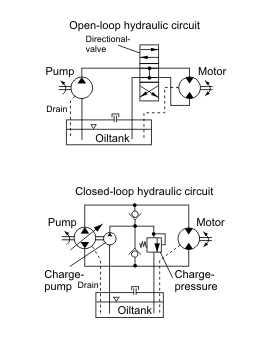Hydraulic machinery
Hydraulic machinery refers to machines and equipment that use fluid power to do simple work. Heavy equipment is a common example. In this type of machine, hydraulic fluid is transmitted throughout the machine to various hydraulic motors and hydraulic cylinders and becomes pressurized according to the resistance present. The fluid is controlled directly or automatically by control valves and distributed through hoses and tubes.
The simplicity of hydraulic systems allows for the easy transfer of force from one location to another with minimal loss in energy. Hydraulic machinery is widely used in various industries including construction, manufacturing, and mining due to its efficiency and capability to generate immense power.
Components of Hydraulic Machinery[edit | edit source]
The operation of hydraulic machinery involves several key components:
- Hydraulic Pumps: These convert mechanical power into hydraulic energy by forcing fluid from the reservoir into the system.
- Hydraulic Cylinders: These act as actuators and convert the hydraulic energy back into mechanical power to perform work.
- Hydraulic Motors: Similar to cylinders, these convert hydraulic energy into mechanical energy but are used to drive rotary movements.
- Control Valves: These regulate the flow and pressure of the hydraulic fluid, controlling the direction and force of the hydraulic actuator.
- Reservoir: A tank that holds the hydraulic fluid.
- Hoses and Tubes: Channels that transport the hydraulic fluid to and from different components of the hydraulic system.
Principle of Operation[edit | edit source]
Hydraulic machinery operates based on Pascal's Law, which states that pressure applied to a confined fluid is transmitted undiminished in every direction throughout the fluid. This principle allows hydraulic systems to amplify force with ease and precision.
Applications[edit | edit source]
Hydraulic machinery has a wide range of applications due to its versatility and power. Some common applications include:
- Excavators and backhoes in the construction industry for digging and moving earth.
- Hydraulic presses in manufacturing for molding, shaping, and pressing materials.
- Aircraft control systems, where hydraulics are used for actuation of control surfaces.
- Power steering, brakes, and transmissions in automotive applications.
Advantages and Disadvantages[edit | edit source]
Advantages[edit | edit source]
- High power-to-weight ratio, allowing for the generation of large forces from small, lightweight systems.
- Precise control of movement and force.
- The capability to be easily scaled in size for different applications.
Disadvantages[edit | edit source]
- Potential for hydraulic fluid leaks, which can lead to environmental and safety hazards.
- The need for regular maintenance to prevent breakdowns and ensure safety.
- Sensitivity to temperature changes, which can affect performance.
Future Trends[edit | edit source]
The future of hydraulic machinery involves advancements in hydraulic fluids, energy efficiency, and sustainability. Innovations in materials and technology aim to reduce the environmental impact of hydraulic systems while enhancing performance and reliability.
Navigation: Wellness - Encyclopedia - Health topics - Disease Index - Drugs - World Directory - Gray's Anatomy - Keto diet - Recipes
Search WikiMD
Ad.Tired of being Overweight? Try W8MD's physician weight loss program.
Semaglutide (Ozempic / Wegovy and Tirzepatide (Mounjaro / Zepbound) available.
Advertise on WikiMD
WikiMD is not a substitute for professional medical advice. See full disclaimer.
Credits:Most images are courtesy of Wikimedia commons, and templates Wikipedia, licensed under CC BY SA or similar.Contributors: Prab R. Tumpati, MD





